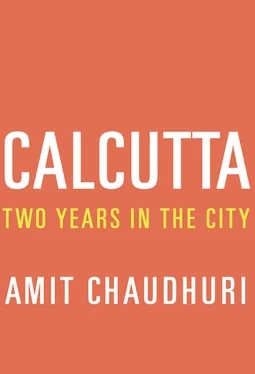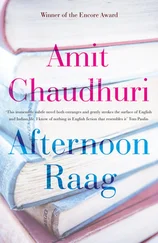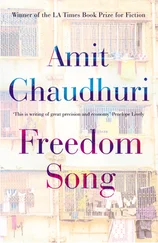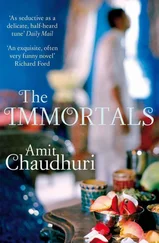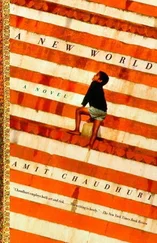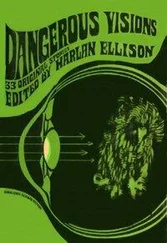When Manoj introduced me to Sen, I was already pretty well-disposed towards him. He had a reputation for being unostentatious, serious, and, despite being a hardcore Marxist, an advocate of change. There was an allegation against him — a “canard,” according to Manoj — of being involved directly in the Sainbari murders in Burdwan in 1970: gruesome killings of a family that had strong allegiances to the Congress Party. In 2008, the case was as remote from the consciousness as the dead themselves; I myself hadn’t heard of it. Anyway, industry in Calcutta had decided it had in Sen a person it could work with. Whatever he might be like with his comrades or to his enemies, whatever he was really like, in his conversation with me he was humane and non-ideological. In the end, it’s hard to decide about the value of one’s own impressions. Still, I realised I could open up with him in a way I couldn’t with Bengali Marxist sympathisers — some of whom belong to my extended family. The latter used to be swift to take offence if you breathed any kind of criticism about the party or the state (the two had become conflated in their minds). Sen was easier to talk to; you didn’t have to constantly worry about outraging him, as you might have if, for instance, you were speaking with the grand old man of Bengali Marxists, the last chief minister, Jyoti Basu. But this was the new face of the party under Buddhadeb Bhattacharya: less prickly, more approachable; more self-questioning, less defensive; less of a stickler, at least to the naive observer, for the Communist rulebook. So I wasn’t wholly surprised when Sen told me how close the party had been to losing power to Mamata Banerjee. We already knew this; nevertheless, the candid admission cleared the air. We discussed societies in transition; I reflected on how resistant and unionised Britain had become in the late seventies (around when the Left came to power in Bengal), how it took Thatcher to heartlessly, ruthlessly, break the unions, and the Labour Party to respond by mutating into New Labour. The situation in Bengal today was, in some ways, comparable. Sen nodded throughout. This is not to say that I, and presumably he, wanted the Bengali equivalent of Margaret Thatcher to emerge in Calcutta. But it was good to have the freedom to pursue these analogies till they fell apart, without, in Sen’s company, having the ghost of self-censorship hover over the conversation. Such was the equable air of the minister for industrial reconstruction.
Almost three years later, in March 2011, I decided it was time to see Sen again. A lot had happened since that dinner; and the state assembly elections — the most important elections in sixty-four-year-old West Bengal since 1977—would take place in April. After 2009, after the humiliating loss of Tata’s Nano factory to Gujarat, and the setback in the general elections, the Left had retreated into a shell. It seemed to be biding its time, going through the motions of governance before its inevitable departure from office. Meanwhile, everywhere there had been talk, for more than two years now, of “change” or “paribartan.” It originated in a seemingly spontaneous movement that came into being (with a great deal of middle-class support) in relation to the farmers and peasants of two obscure locations outside Calcutta, Singur, a small town, and a village, Nandigram. After the emergence of this movement, whose rhetoric of resistance and redressal at some point merged into the Trinamool Congress’s rhetoric of removal — the removal of the Left Front government — the notion of “change” in Bengal became a different one from the idea introduced not long ago by the communists: of change within the party and the state; of a calculated embrace of industrialisation, investment, and development. Now, “change” came to imply the urgency of a change of government; and the Left Front came to be synonymous with repression and fixity. These thoughts had been in the air for a while, but suddenly they rose to the foreground of the consciousness. The mood was like a contagion in middle-class Calcutta and beyond; everyone, even those who didn’t want to catch the infection, caught it, and showed all the symptoms. The Left must go.
At certain points in modern Indian history, obscure villages and locations, whose names invoke millennia of stasis, become incandescent with some debate that’s central to the nation’s consciousness. This happens without the nation necessarily having been aware of that issue’s centrality — until the flashpoint, when the unknown place becomes a battleground. After that moment, the location may well enter the history books, while remaining, in every other sense, unimportant.
Sometimes the battle is a real one. For instance, who’d heard of Palashi, or Plassey, in Bengal, before Siraj-ud-daula capitulated to Clive’s troops in 1757, opening the door to Empire? For that matter, who’s heard of it since?
During the freedom struggle, an outpost called Chauri Chaura became briefly famous when a group of protesters set fire to a police station, causing Gandhi to suspend his satyagraha movement until it returned to non-violent ways.
The peasant uprising in a region called Telengana in the late forties was the first anti-landlord movement in independent India. Its successor, which emerged from the equally little-known Naxalbari in North Bengal, led to the first formal, and violent, articulation of Maoism.
In 1998, the right-wing Bharatiya Janata Party government exploded five nuclear devices at a test range in Rajasthan called Pokaran. The following year, the Pakistani army, directed in the background by General Musharraf, initiated an invasion into the Kashmiri border, in a mountainous and unheard-of district called Kargil, specifically shelling Dras, a town no one had heard of.
What do these names, otherwise seldom uttered, tell us? Firstly, they resist the banality of the contemporary. We can’t imagine mentioning them in the same breath as shopping malls and the new Apple product. We also can’t imagine, or foresee, how a place like Dras might one day converge with the known world of malls and Apple products; though it well might. These locations and towns and villages represent a remoteness and inert changelessness; then, briefly, we realise that — beyond the bounded environment of the metropolis — this is precisely the India that is, and historically has been, in a state of siege.
To this roster of obscure names, whose effect on the consciousness is both undeniable and difficult to pin down, must be added Singur and Nandigram.
Nandigram is a village in Purba Medinipur district, its inhabitants mainly farmers and mainly Muslim. Like most other villages in the Bengal of the last four decades, it was, traditionally, a communist outpost. The land reforms brought about by the Left Front government — redistributing land controlled by landlords among peasants, ending centuries of oppression — is its single greatest achievement, and one that’s not to be belittled.
That trouble began in Nandigram, one of the many villages that had benefited from land reform, was ironical; it also pointed to the compulsions of the Left Front under Buddhadeb Bhattacharya. The state was probably near bankrupt; agriculture was no longer productive; the world had globalised, the Berlin Wall long fallen, a new sort of economic game was being played worldwide, and you needed to participate to be able to generate money. The advent of Indonesia’s Salim Group was announced celebratorily in Bengal. Special economic zones were being created throughout India since the early 2000s; land purchased, or even wrested, from peasants to make space for focussed development and industry. Nandigram was the first village to resist being transformed into a special economic zone, in the process becoming not only a distinct entity within the state, fortressed, oppositional, neither of Bengal nor not of it, but scuppering both Bhattacharya’s and the Salim Group’s plans. It was a classic David and Goliath story — with a twist to the confrontation since, here, Goliath, formerly the progenitor and nurturer of David, had sneakily turned upon him.
Читать дальше
